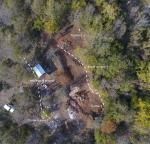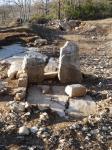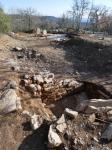Summary (English)
Some time ago, the Salingolpe Archaeological Group (Castellina in Chianti) had noted the presence of several stone slabs fixed vertically in the ground in a rather sparse wood on the south side of a high hill dominating a vast territory just south of Castellina. The slabs emerged from the ground and fragments of coarse ware pottery were visible on the surface in the area around them. In order to evaluate the nature of the archaeological deposit, that suggested the existence of the remains of an Etruscan chamber tomb, the first excavation campaign took place in 2107, although it was halted at one point due to the discovery of two hand-grenades. Its strategic position, dominating the road network and territory, meant that during the Second World War there was bitter fighting here between the allied troops and the German army.
The excavations confirmed the existence of an Etruscan necropolis but also revealed traces of Roman occupation and of the quarrying of the compact limestone (albarese), which forms the hill’s geological substrata, perhaps in the medieval period. In the 6th century BC, the outcrop of albarese stone was used as the base on which to construct two chamber tombs, covered by a tumulus, whose walls were formed by large stone slabs fixed into the soil or by courses of smaller stones bonded with clay, in a technique already documented in the Chianti area (Poggino di Fonterutoli).
The remains of the tomb groups, constituted by impasto, bucchero, and Etrusco-Corinthian pottery, indicate that the necropolis was in use in the 6th century B.C. In the Roman period (mid 1st century B.C. – 1st century A.D.), a house probably stood in the area between the two excavated tombs, as attested by the materials (pottery and coins) found in a heap of soil. This accumulation appeared to result of the digging of the soil covering a thick layer of limestone used in a later period. The stone quarrying, for which two fronts have been identified, partially destroyed the walls of the chamber tombs and the Roman house, producing an extensive layer of stone chippings along the quarry front and, immediately downhill, an accumulation of the soil dug away from the stone. Two iron wedges were found among the stone chippings, and at the quarry front, there were the tools that document this activity. However, for the dating of the activity we only have the terminus post quem provided by the Roman materials from the soil heap. It is likely that the quarrying relates to the construction of the 15th century fortifications of Castellina, although a nearby quarry was active until a few years ago.
- Marco Firmati - Museo Archeologico del Chianti senese, Castellina in Chianti SI
Director
Team
- Vito De Meo - Gruppo Archeologico Salingolpe, Castellina in Chianti SI
Research Body
Funding Body
- Comune di Castellina in Chianti (SI)
- Gruppo Archeologico Salingolpe - Castellina in Chianti (SI)






![Download [PDF]](/excavation/skins/fasti/images/results/download_sml.png)

